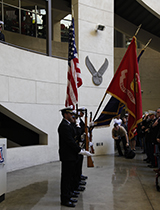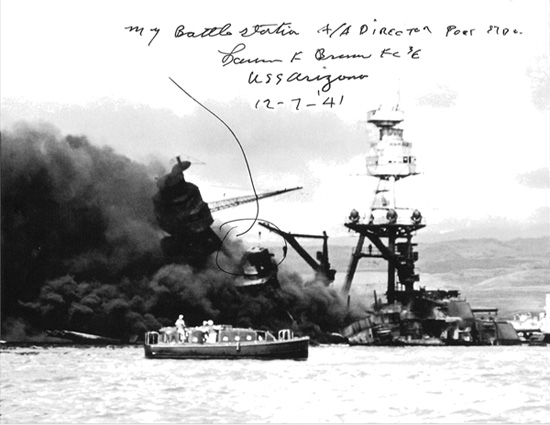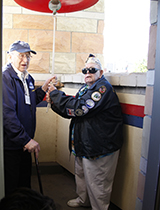
By Christopher Conover and Zac Ziegler
Listen to the story by Christopher Conover:
Monday marks 74 years since the Japanese attacked Pearl Harbor. The attack damaged 18 ships, including all eight battleships in the Pacific Fleet. The USS Arizona was one of two battleships that never returned to action; 1,177 of the ship's crew members died on the Arizona.
Hundreds gathered Sunday at the University of Arizona's Student Union Memorial Center for the annual honoring of those who died on the Arizona .
Enlisted, ROTC members, veterans and citizens gathered at the first floor of the building's rotunda, which was built to represent one of the ship's gun barrels. The crowd overflowed from the first floor, spilling out along the stairwells and decks that overlook the space on the four floors above.
Bill Westcott was among the speakers at the event.
Westcott's uncle, William Westcott died on the Arizona during the attack. He said the attack led to his father enlisting at the age of 16.
 Members of the UA NROTC present the flags at the start of the ceremony.
Members of the UA NROTC present the flags at the start of the ceremony.
The memorial would place an outline of the ship on the ground of the mall, and include a medallion for each man that died, with information like name, rank, birth year and death year on the medallion.
"It is our hope that the 40,000 students that walk across that mall to see '1923-1941'," he said. "And realize that every single one of those medallions is a day of death exactly the same."
The ceremony was concluded with the ringing of the bell from the Arizona, which now hangs in a tower at the Student Union Memorial Center. A lone trumpet then played Taps.
The bell was rang by two men who were stationed on the Arizona and survived the attack.
Two special honorees
Lauren Bruner and Clarendon "Clare" Hetrick were aboard the USS Arizona on Dec. 7, 1941. Unlike most of their shipmates, they made it off.
Hear an interview with Clare Hetrick by AZPM's Zac Ziegler
Hetrick was in the forward latrine when the attack came, getting ready to take liberty in Honolulu.
When he made it to the surface, he saw the "big red ball" on the attacking planes' wings. A sign that they were Japanese.
Hetrick rushed to his position sending ammunition up to the guns. When his position was hit, he headed to the Arizona's deck and jumped into the harbor as ordered despite the fact that he did not know how to swim.
Hear an interview with Lauren Bruner by AZPM's Christopher Conover
Lauren Bruner also went straight to his battle station when the Japanese attack began.

He was part of a six-man crew that worked anti-aircraft guns above the admiral's deck. He and the others had to abandon the guns once the gunpowder stores were hit.
"We were about 80 feet up in the air with no way to get down and oil burning down below," he said.

They had a line tossed to them from a nearby ship, and they were able to crawl down the line to the other vessel.
Bruner was injured while fighting back; he had burns on over 70 percent of his body.
Both men went on to fight in the war, serving on other ships in the Pacific theater.
On Sunday, they both stood together after the ceremony on the fourth floor of the Student Union Memorial Center and rang the bell that once hung in the Arizona.
Hetrick said it was the second time he has rung the bell of the Arizona. The last time was about 10 years ago.

By submitting your comments, you hereby give AZPM the right to post your comments and potentially use them in any other form of media operated by this institution.